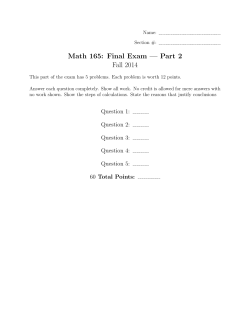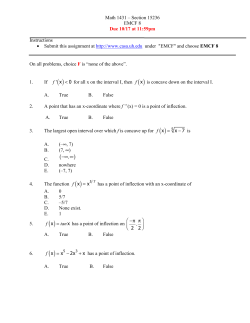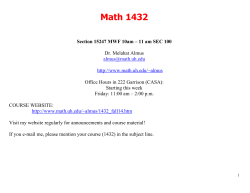
PE Answers
Practice Exam 2 0) [§5.1 - §5.3] Describe the following in your own words: a) How to find on what intervals a function is increasing/decreasing. Take the first derivative, set it equal to 0, solve for x. Test values in each resulting interval. If positive, the function is increasing. If negative, decreasing. b) How to find relative maxima and minima. Same process as above, but if a function switches from increasing to decreasing at x = c, it has a relative maximum at (c, f (c)). Likewise for decreasing to increasing and relative minimum. c) How to determine the intervals where a function is concave up/concave down and where the inflection points are. Same as part a except using the second derivative. If positive, concave up. If negative, concave down. If a function switches concavity at x = c, then (c, f (c)) is an inflecting point if c is in the domain of f (x). 1) [§5.1] Determine all intervals where each function is increasing/decreasing. 2 a) f (x) = x3 − x2 − 4x + 2 3 Increasing on (−∞, −1) and (2, ∞), decreasing on (−1, 2) b) g(x) = 4x3 − 15x2 − 72x + 5 Increasing on (−∞, −1.5) and (4, ∞), decreasing on (−1.5, 4) c) y = −3x + 6 Decreasing everywhere d) h(x) = 4 Neither everywhere e) f (x) = x2 ex Increasing on (−∞, −2) and (0, ∞), decreasing (−2, 0) f) Also look at page 260 numbers 1 through 8. Expect to see a question like one of these on the exam in addition to any of the above. 2) [§5.2] Determine where each function below has relative maxima and minima, if any. Your answer must be in the form of an ordered pair (x, y) to receive credit. a) f (x) = x3 + 6x2 − 15x + 2 Relative Max at (−5, 102). Relative Min at (4, 102). b) x2 + 8x − 20 Relative Min at (−4, −36). c) r(x) = x No extrema d) x3 ex Relative Min at (−3, −1.344) e) Also look at page 271 numbers 1 through 8. Expect to see a question like one of these on the exam in addition to any of the above. 3) [§5.3] a) Find the first 6 derivatives of f (x) = 3x3 + 9x2 + 100x + 10. f 0 (x) = 9x2 +18x+100; f 00 (x) = 18x+18; f 000 (x) = 18; f (4) (x) = 18; f (5) (x) = 0; f (6) (x) = 0 b) Find the first 3 derivatives of f (x) = xex . Notice a pattern? If not, find 3 more derivatives. Derive a formula for f (n) (x), the nth derivative of f (x). f 0 (x) = xex + ex ; f 00 (x) = xex + 2ex ; f 000 (x) = xex + 3ex ; f (n) (x) = xex + nex c) Find the first 3 derivatives of g(x) = ex . What is the g (100) (x), the 100th derivative of g(x)? Derive a formula for g (n) (x), the nth derivative of g(x) g 0 (x) = ex ; g 00 (x) = ex ; g 000 (x) = ex . . . g (n) (x) = ex d) Find the first 4 derivatives of h(x) = ln(x). Do you see a pattern? If not, find 3 more derivatives. Derive a formula for f (n) (x), the nth derivative of h(x). (Recall the notation n! = n∗(n−1)∗(n−2) . . . 3∗2∗1, called n factorial. e.g. 6! = 6*5*4*3*2*1 = 720) h0 (x) = 1 00 −1 −2 −6 (−1)n+1 n! ; h (x) = 2 ; h000 (x) = 3 ; h(4) (x) = 4 ; h(n) (x) = x x x x xn e) A car’s distance function is given by s(t) = t3 − 2t2 − 7t + 9 where t is time in seconds. What is the acceleration of the car after 6 seconds?. (Recall that I briefly mentioned that the derivative of distance is velocity and the derivative of velocity is acceleration) a(t) = 6t − 4; a(6) = 32 distance units per seconds 4) [§5.3] Determine where the following functions are concave up or concave down. Also note any inflection points as ordered pairs (x, y) a) f (x) = x4 − 8x3 + 18x2 Concave up on (−∞, 1) and (3, ∞), concave down on (1, 3). Inflection at (1, 11) and (3, 27). b) g(x) = x4 − 3x3 + 3x2 − x + 1 Concave up on (−∞, .5) and (1, ∞), concave down on (.5, 1) Inflection at (.5, 3.5625) and (1, 11) c) h(x) = xex Concave up on (−2, ∞), concave down on (−∞, −2). Inflection at (−2, −.2707). d) y = 4 x+2 Concave up on (−2, ∞), concave down on (−∞, −2). No inflection points. e) f (x) = 4x No concavity. No inflection points. f) Also look at page 283 numbers 27 through 32 in the text. 5) [§6.1] Find any absolute extrema of the following in the given interval. a) f (x) = √ x ; [1, 3] √ Absolute Max at (1, 1), Absolute Min at (3, 3) b) g(x) = 2x3 + 1 on [0, 1] Absolute Max at (1, 3), Absolute Min at (0, 1) c) h(x) = x2 on (−∞, ∞) Absolute Min at (0, 0) d) 1−x on [0, 3] 3+x 1 1 Absolute Max at (0, ), absolute Min at (3, − ) 3 3 e) Also look at page 309 numbers 1-8 in the text. Problems 6 through 12 are all from section 6.2 in the book. 6) Find two non-negative numbers x and y such that: a) x + y = 90 and xy is maximized x = 45, y = 45 b) 2x + y = 60 and x2 y is maximized x = 20, y = 20 c) x + 2y = 30 and x2 + y 2 is maximized x = 6, y = 12 7) A fence is to be build to enclose a rectangular area of 25,600 m2 . One side of the area is bounded by an existing fence; no fence is needed there. Material for the fence costs $3 per meter for the two ends and $1.50 per meter for the side opposite the existing fence. Find the cost of the least expensive fence. [Pg. 319, #13] $960 8) A group of recycling enthusiasts have been collecting aluminum cans for a fundraiser. They have currently collected 12,000 pounds of cans for which they could receive $7.50 per hundred pounds. The group can collect cans at the rate of 400 pounds per day but the recycling center has announced that they will pay $0.15 per day less from now on. The group can only make one trip to the center. When is the best time to go to maximize profit? [319, #17] Collect for 10 more days 9) Suppose CRT televisions are making a comeback. Samsung needs to design an opentopped box with a square base to ship the new TVs in. The box must have a volume of 32 in3 . Find the dimensions of the box that can be built with the minimum amount of materials. [320, #19] 8 by 8 by .5 . . . Yeah, I know a CRT won’t fit in there. They’ll have to increase the volume or accept they can’t use the minimum amount of material. That’s how it is in business. 10) An open box will be made by cutting a square from each corner of a 3’ by 8’ piece of cardboard and folding up the sides. What size square should be cut from each corner to produce a box of maximum volume? [320, #21] A square with sides of length 2 foot. 3 11) Your company needs to design cylindrical metal containers with a volume of 16 cubic feet. The top and bottom will be made of sturdy materials that cost $2 per square foot, while the material for the sides costs $1 per square foot. Find the radium, height, and cost of the least expensive container. [320, #26] Radius ≈ 1.08 ft. Height ≈ 4.37 ft. Cost = $44.29 12) The U.S. Postal Service stipulates that any boxes sent through the mail must have a length plus girth totaling no more than 108 in. (This is actually true.) (See the figure on page 321, the girth is just the perimeter of the end side). Find the dimensions of the box with maximum volume that can be sent through the U.S. mail, assuming that the width and the height of the box are equal. [321, #47] 18 by 18 by 36 13) [§6.4] Find dy/dx by implicit differentiation for the following: a) 6x2 + 5y 2 = 36 −6x dy = dx 5y b) 8x2 − 10xy + 3y 2 = 26 dy −8x − 5y = dx −5x + 3y c) 5x3 = 3y 2 + 4y 15x2 dy = dx 6y + 4 d) x3 ey − x3 = y 2 −3ey x2 + 3x2 dy = dx x3 ey − 2y e) x + ln y = x2 y 3 dy 2xy 3 − 1 2xy 4 − y = 1 = dx 1 − 3x2 y 3 − 3x2 y 2 y 14) [§6.4] The graph of y 2 (x2 + y 2 ) = 20x2 is called a kappa curve. You can view it on page 335 of the text. Find the equation of the tangent line at the point (1, 2). Expect to see a neat graph like this on the exam and find the equation of a tangent line at a point on it. 10 8 y = x+ 9 9 15) [§6.5] Assume that x and y are both functions of t. Evaluate dy/dt for y 2 − 8x3 = −55 when dx/dt = −4, x = 2, and y = 3. dy = −32 dt 16) [§4.1 - §4.5] On the Notes page I have put up a Derivative Guide in lieu of posting notes for chapter 4. On the last two pages of this Guide there are practice derivatives. Almost every single question on the exam will require taking a derivative. If you can’t confidently take a derivative, you will not do well on the exam.
© Copyright 2025


















